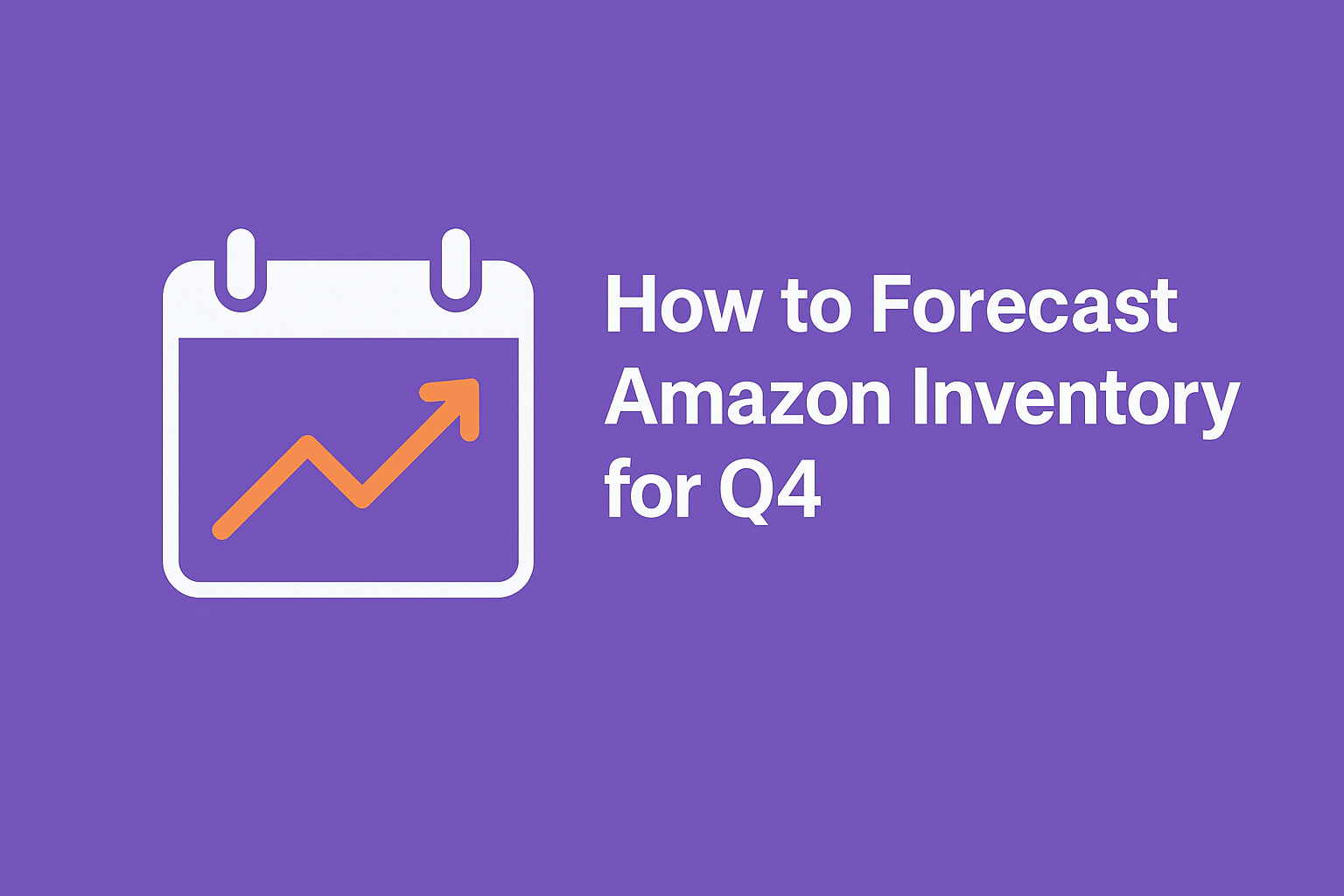How to Forecast Amazon Inventory for Q4
Every Amazon seller fears two things in Q4: running out of stock when sales spike, or overordering and getting crushed by storage fees. The good news? You don’t need to guess. In this article, you’ll learn exactly how to forecast your Q4 inventory using last year’s data, Excel, and a simple monthly process you can reuse every year.
Step 1: Pull Last Year’s Q4 Monthly Sales Data
For Seller Central (FBA Sellers)
- Go to Reports > Business Reports
- Select “Detail Page Sales and Traffic by Child ASIN”
- Set the date range to: October 1 – December 31 of the previous year
- Export the report as a CSV
For Vendor Central (1P Vendors)
- Go to Retail Analytics → Sales → Sourcing View
- Download the sales report for October, November, and December of the previous year
In Excel, summarize the total number of units sold per ASIN for each Q4 month:
- October Units
- November Units
- December Units
Example: If your silicone baking mat sold 600 units in October, 1,200 in November, and 1,000 in December, these are your baseline historical figures.
Step 2: Apply Year-Over-Year Growth Factor
What is a Growth Factor?
A growth factor reflects how much your sales have increased this year compared to last. It helps scale last year’s Q4 data to align with your current business size and momentum.
How to calculate it:
= (Current YTD Sales) ÷ (Last Year’s YTD Sales)Example:
If you’ve sold 36,000 units this year so far, and 24,000 by the same point last year:
= 36,000 ÷ 24,000 = 1.5This means a 50% increase — so apply a growth factor of 1.5 to your Q4 monthly data.
Formula:
= Last Year Month Units × Growth FactorStep 3: Add a Lead Time Buffer
Why buffer matters: Lead time is how long it takes for a reorder to arrive and check in at FBA. This includes production, freight, customs, and warehouse delays. In Q4, those delays often stretch longer. A buffer protects you from stockouts when your sales spike or logistics slow down.
Recommended buffer: Use a buffer equal to your full supply chain lead time — usually 30 to 60 days.
Formula:
= (Monthly Forecast ÷ 30) × Lead Time DaysExample: 1,800 units forecasted in November, with a 45-day lead time:
= (1800 ÷ 30) × 45 = 2,700 units bufferSo plan for 4,500 units total: 1,800 base + 2,700 buffer.
At this point you have concrete forecasted units based on historical data that assumes variables remain constant. Next, we will explore variables/actions you can take that can affect your expected number of units sold per asin.
Step 4: Add Modifiers for This Year’s Sales Levers
What is a Modifier?
Modifiers account for changes you’re making this Q4 — such as promotions, increased ads, better rankings, or price adjustments. These changes can raise or lower your expected sales velocity beyond what history shows.
Examples of modifiers:
- +10% if you’re running a Lightning Deal
- +20% if you’re doubling ad spend
- +15% for improved conversion from new images or A+ content
- −10% if you raised prices and expect slower movement
Formula:
= Forecasted Units × ModifierExample: 1,800 × 1.2 = 2,160 units (20% sales lift expected)
Step 5: Final Forecast Formula (Copy and Paste in Excel)
Use this formula to forecast monthly demand for Q4 with growth, strategy adjustments, and buffer built in:
= (LastYearUnits × GrowthFactor × Modifier) + ((LastYearUnits × GrowthFactor × Modifier) ÷ 30 × LeadTime)
Replace:
LastYearUnits= Units sold in the month last yearGrowthFactor= YTD sales growth ratioModifier= % lift from promos/ads/listing changesLeadTime= Days from PO to FBA check-in
Conclusion: Forecast Q4 Inventory with Confidence
Forecasting isn’t guesswork — it’s a system. By using last year’s Q4 sales, adjusting for this year’s growth, factoring in your current marketing levers, and adding a buffer for lead time, you can forecast your inventory confidently — and protect your Q4 profits.
Your Forecasting Checklist:
- Download last year’s Q4 sales by month
- Calculate this year’s YTD growth factor
- Adjust for price, ad spend, and listing improvements
- Add buffer stock based on your full lead time
- Use your final Excel formula to calculate inventory needed
Run this process now so your orders land on time and fully stocked. A clear forecast is the difference between Q4 chaos and Q4 sales growth.
Our team of Amazon Account Managers are experts at forecasting. We utilize the inventory forecasting framework above, coordinating catalog updates and ad strategy, all together so that our clients are prepared for growth in Q4. If you are interested in having our team grow your Amazon sales, click the blue button at the top of the page to request a free audit of your Amazon account.

Kaleb started his Amazon journey as a data analyst for a wholesale beauty brand, where he helped grow their Amazon sales from zero to over $1 million per month. Since then, he’s worked directly with more than 100 sellers across a wide range of categories, focusing on growing their sales through expert account and inventory management, ad strategy, and catalog optimization. When he’s not working with sellers, you’ll find Kaleb enjoying life with his fiancée Jerah and their dog Clifford, his favorite team outside of Amazon.

